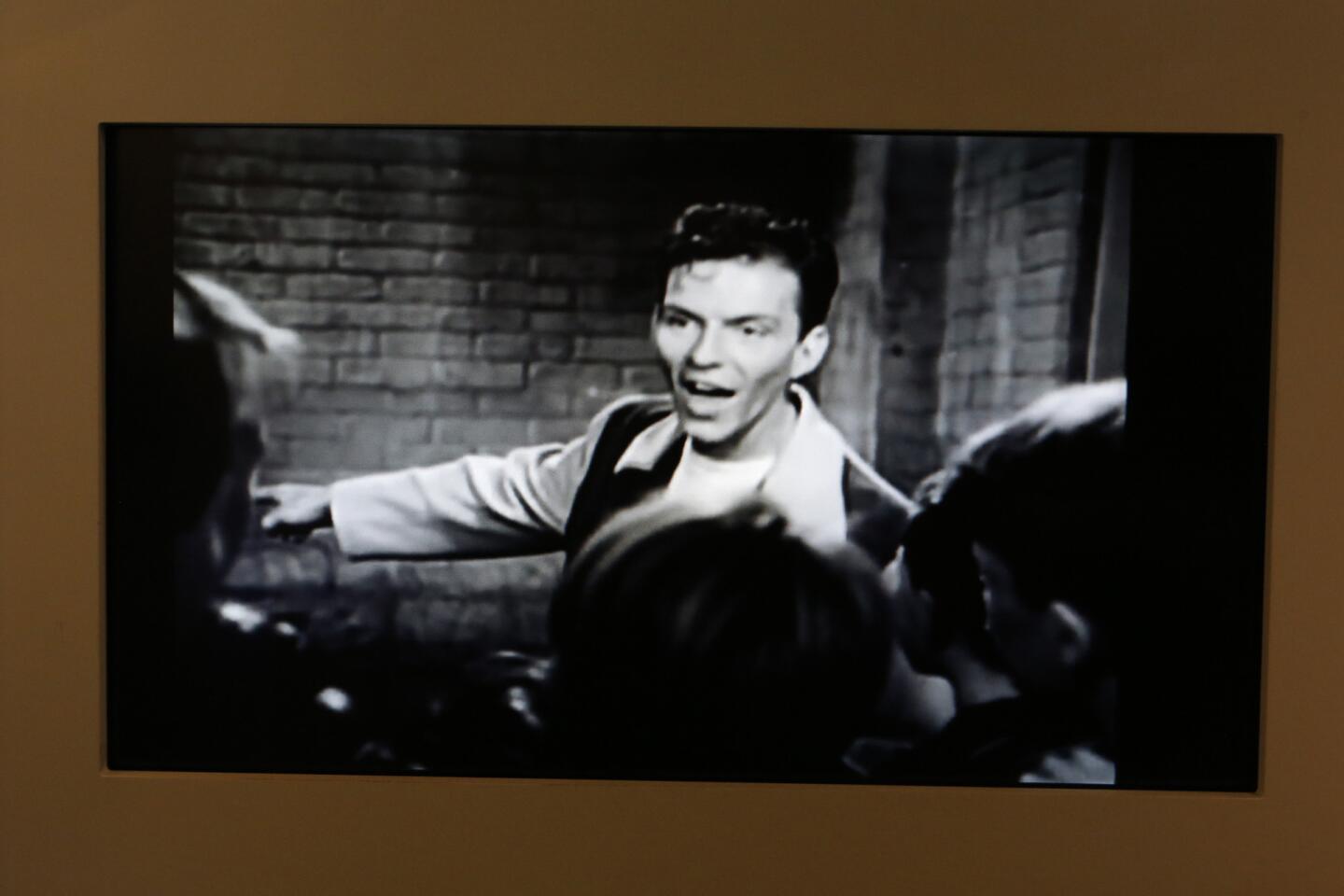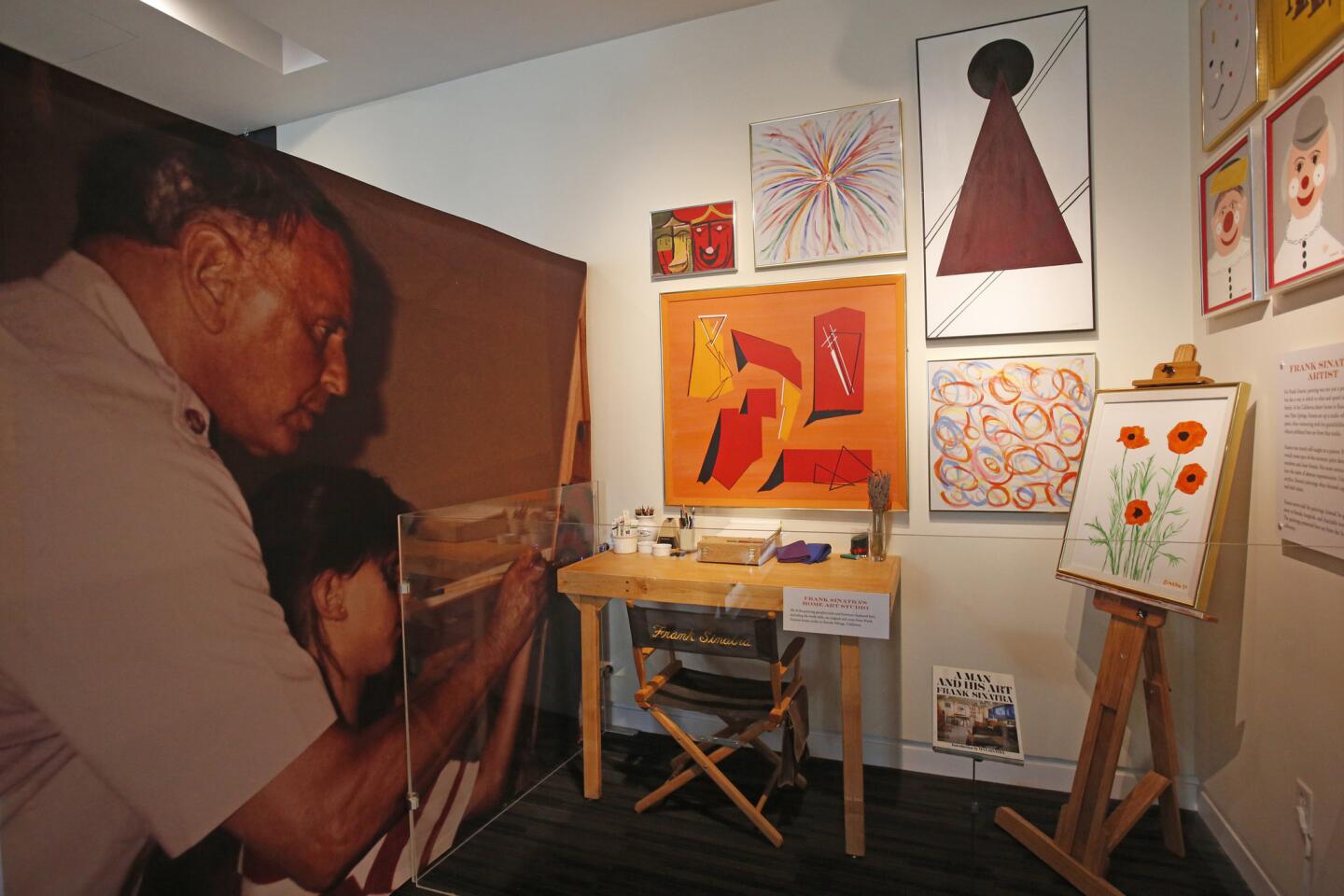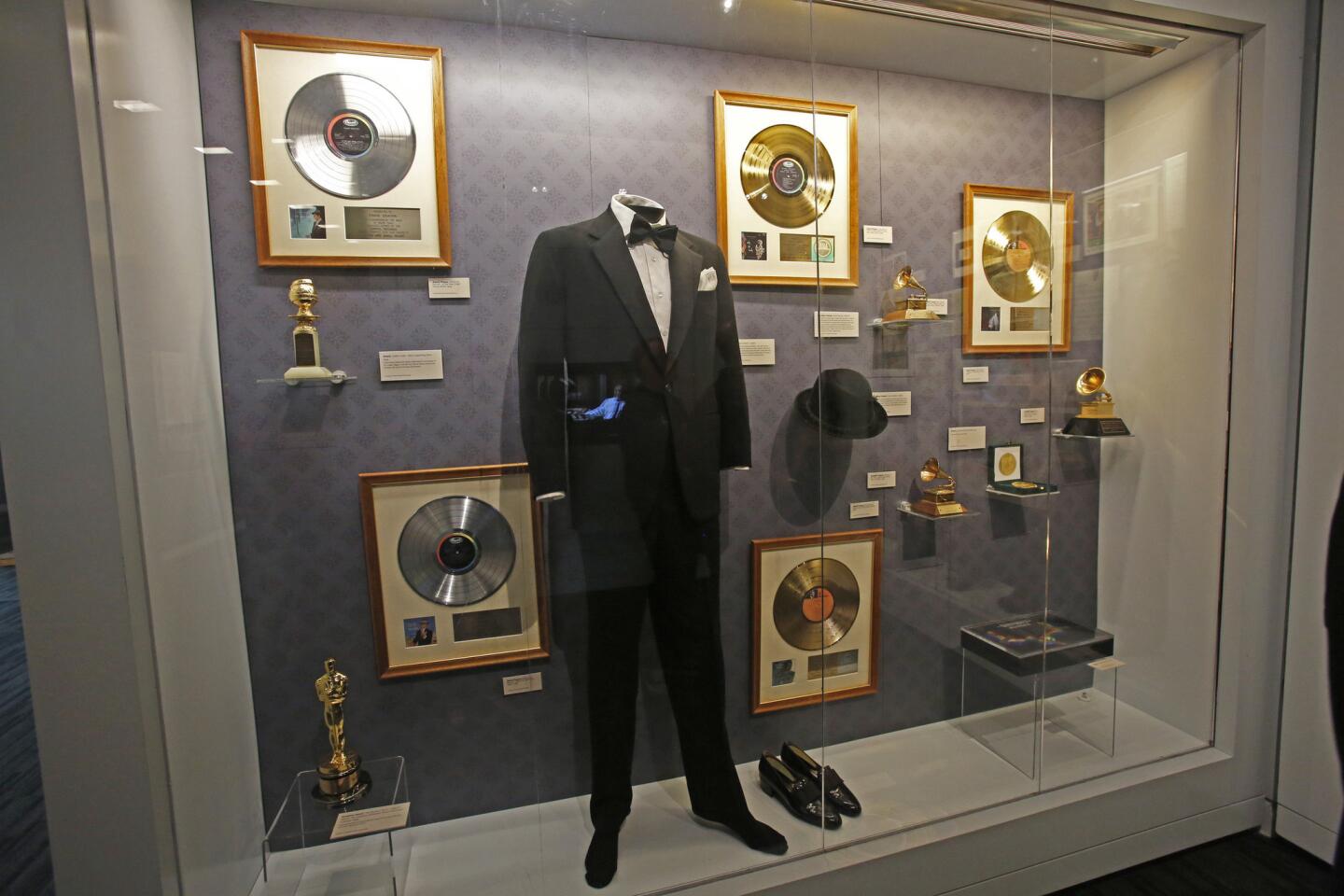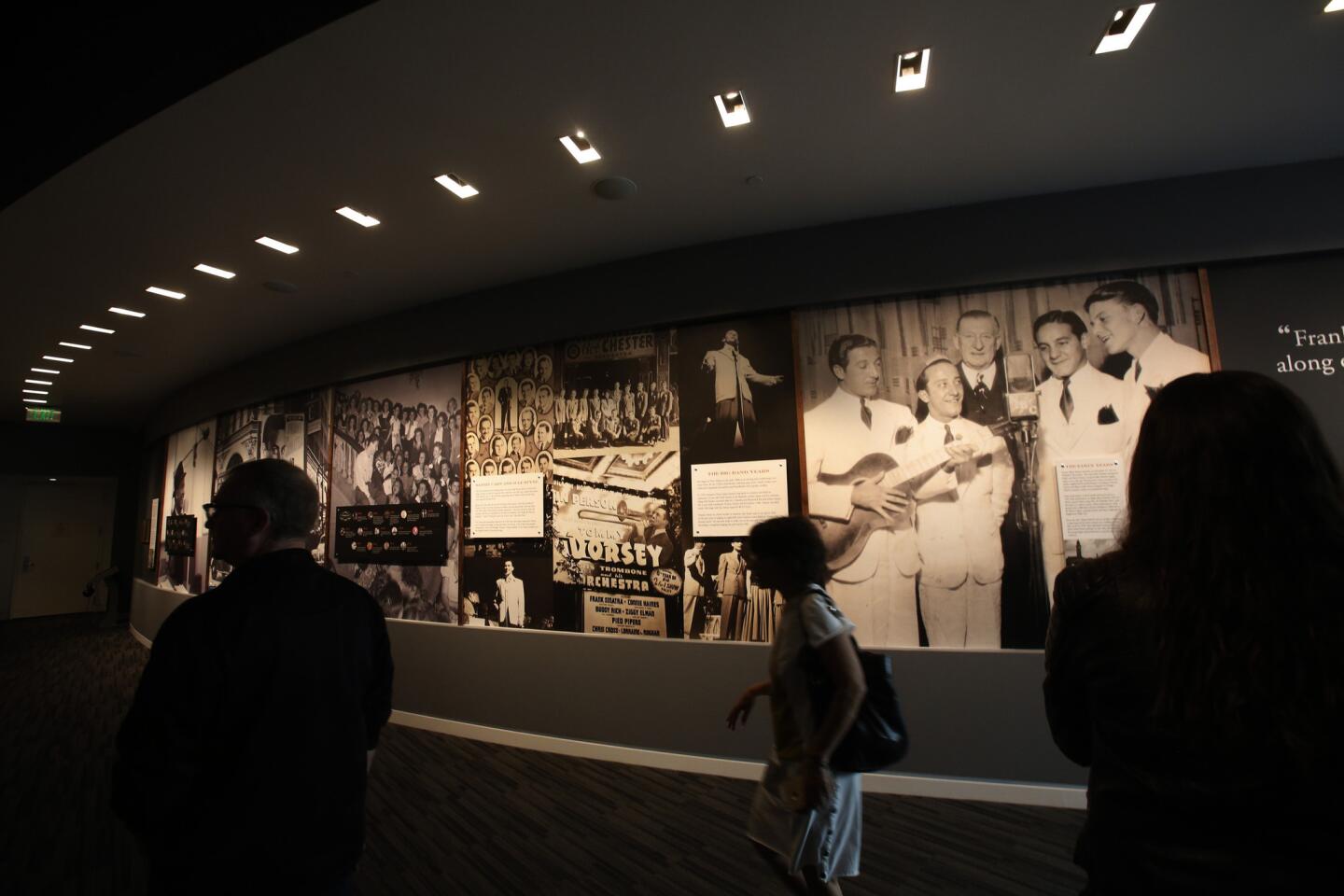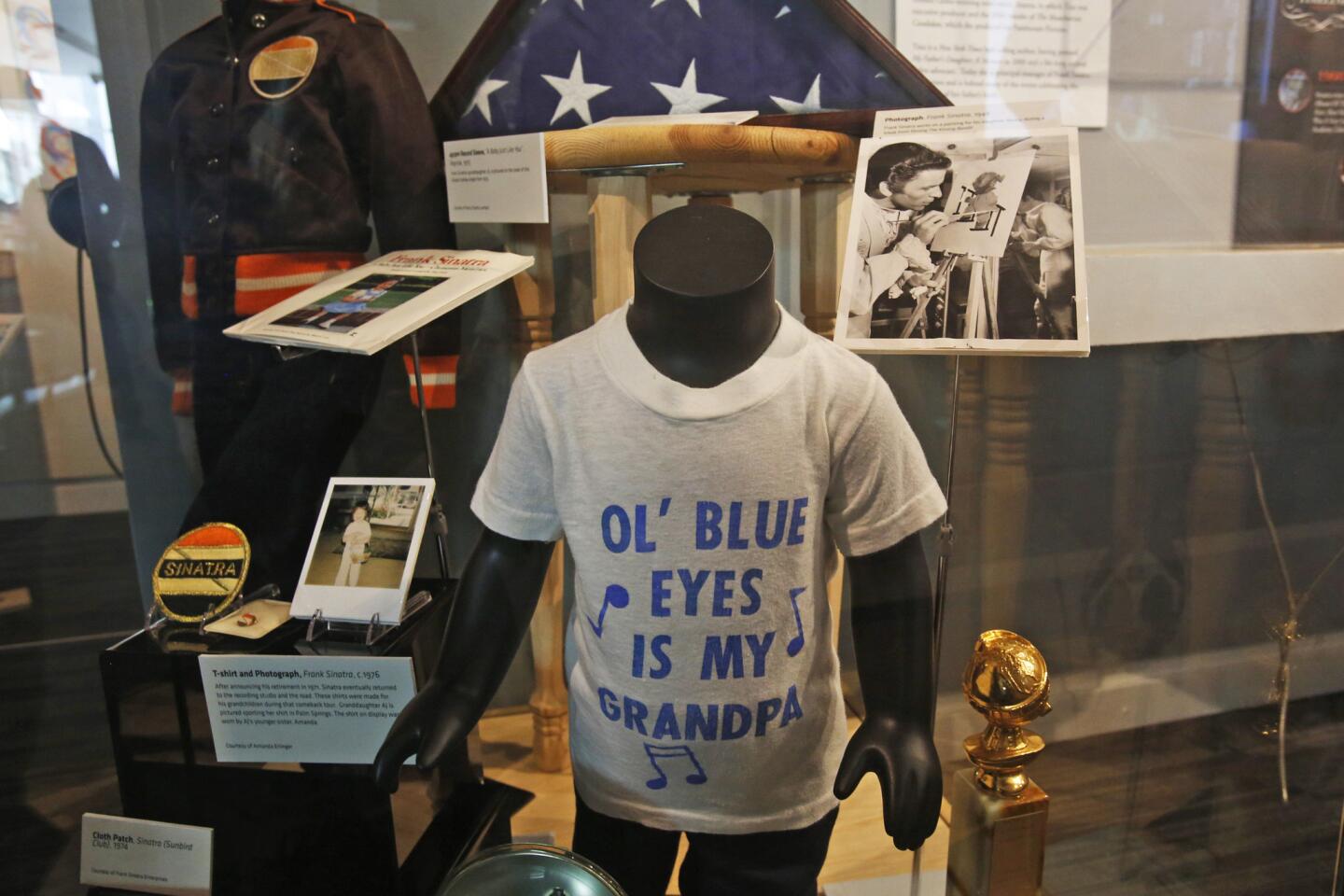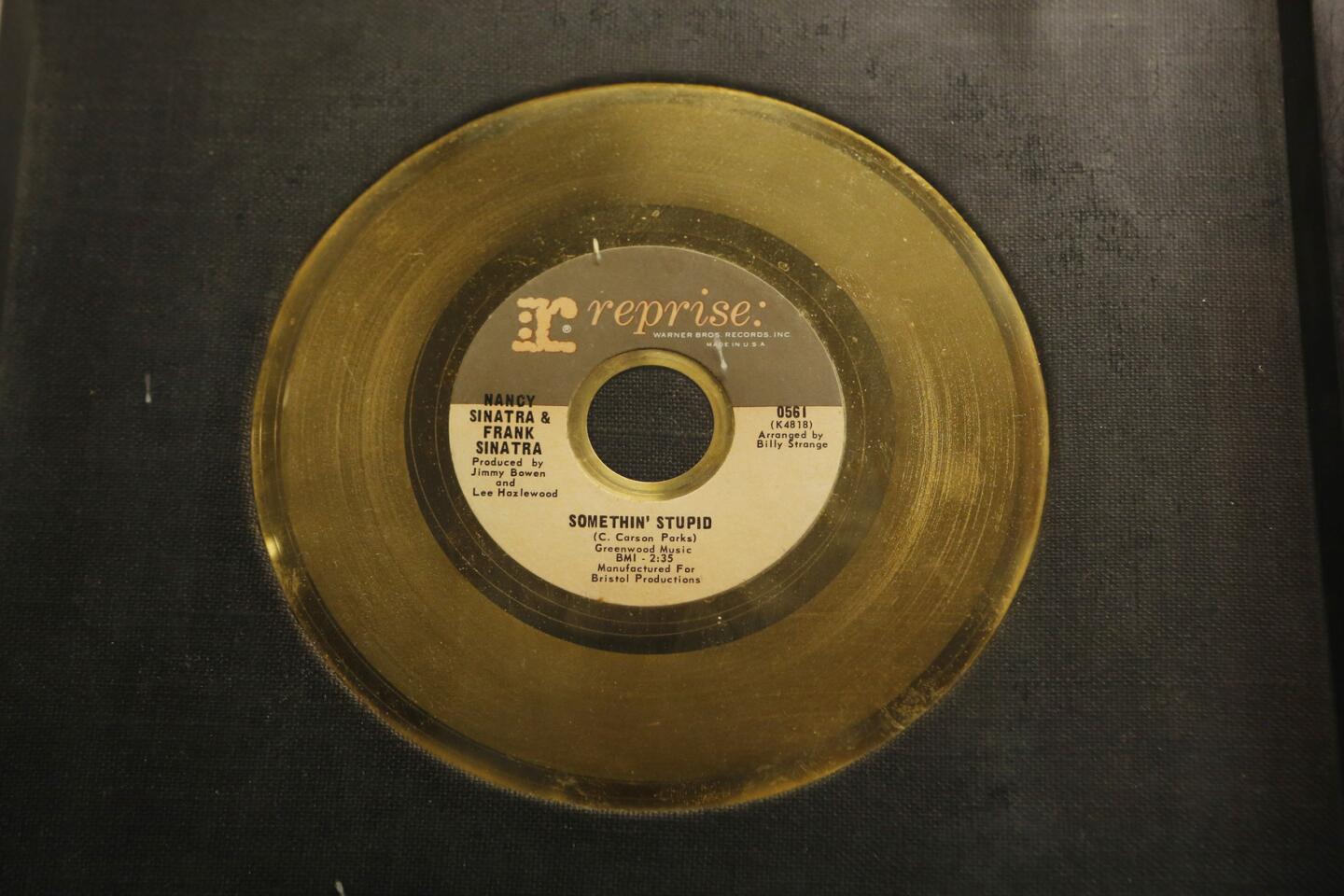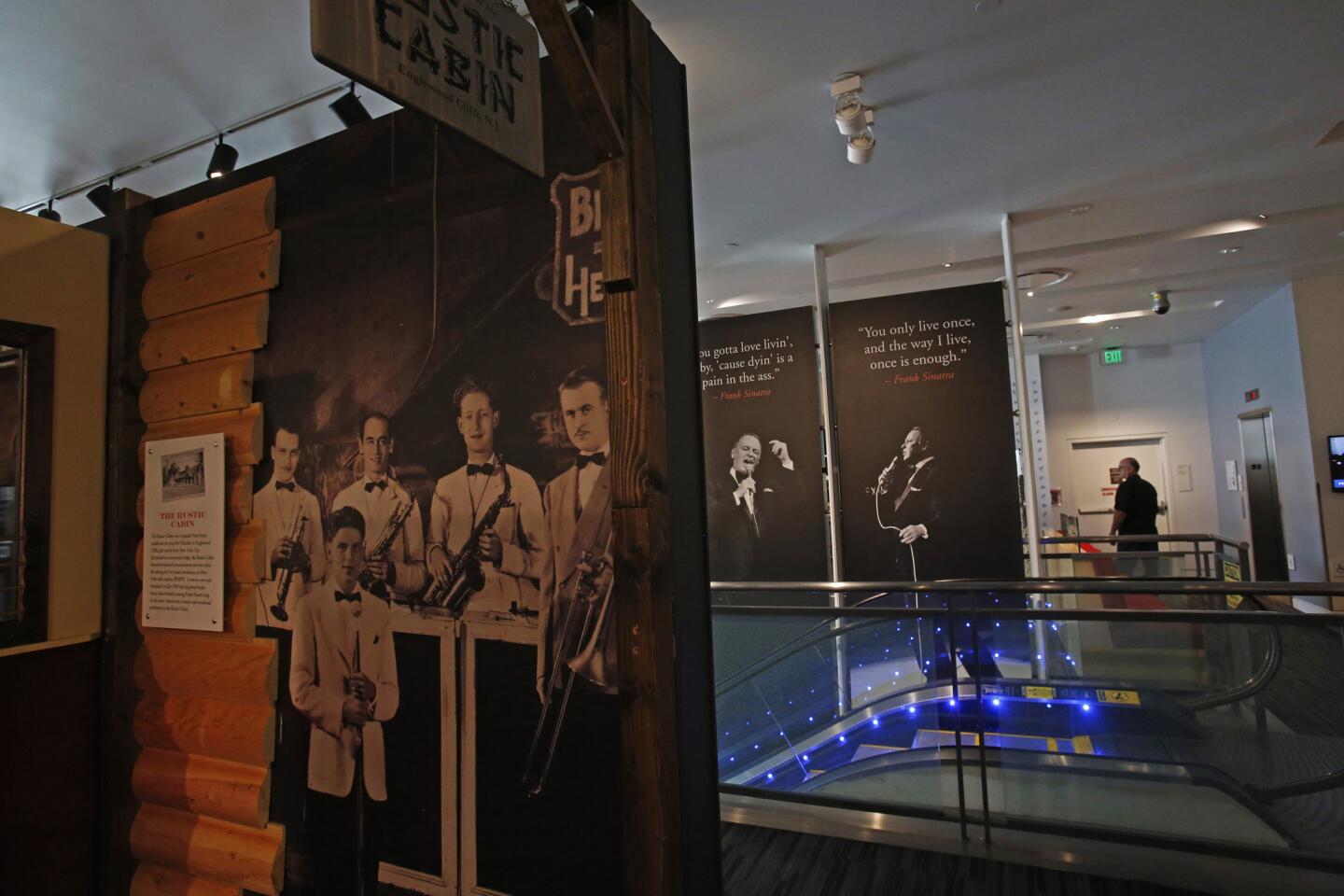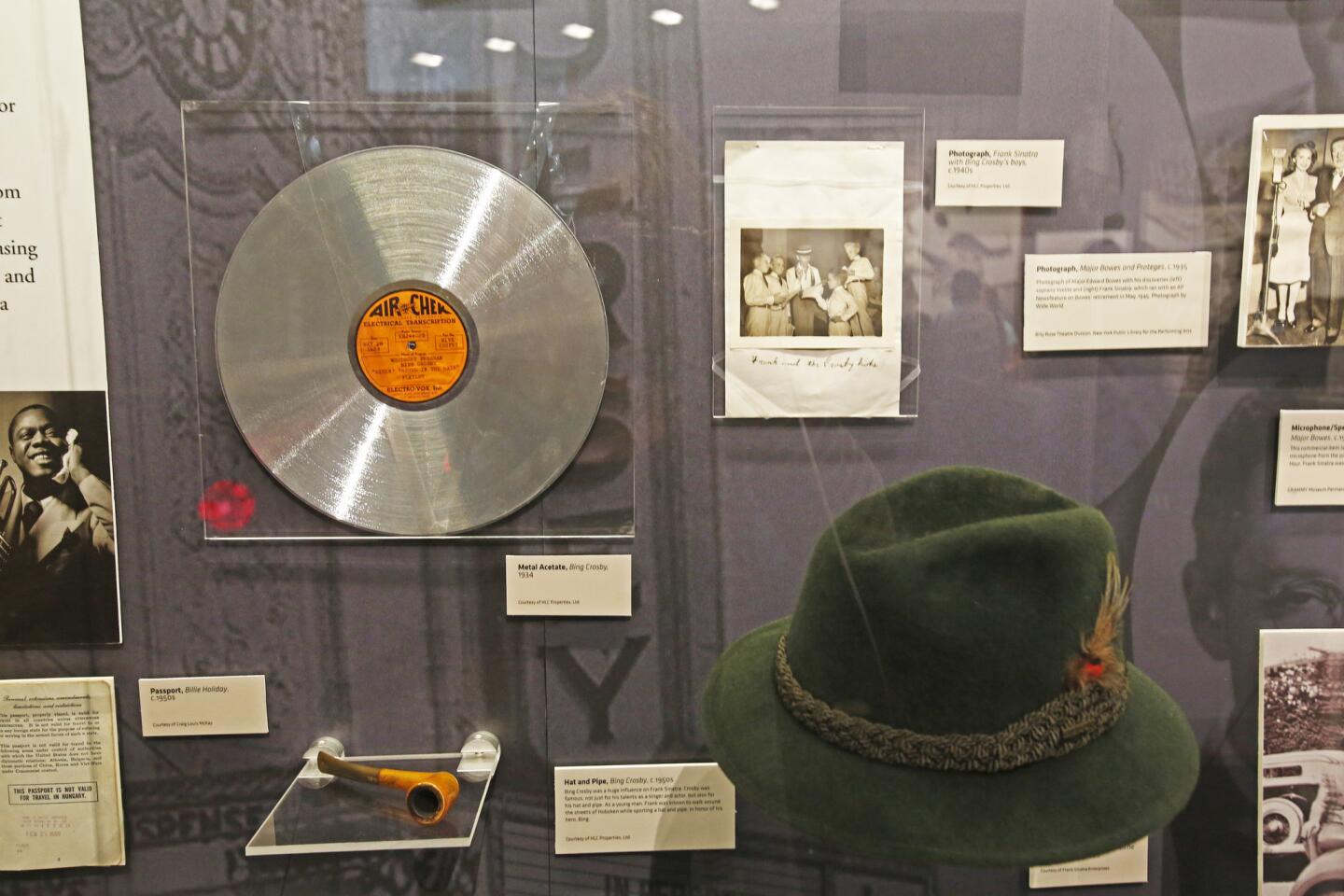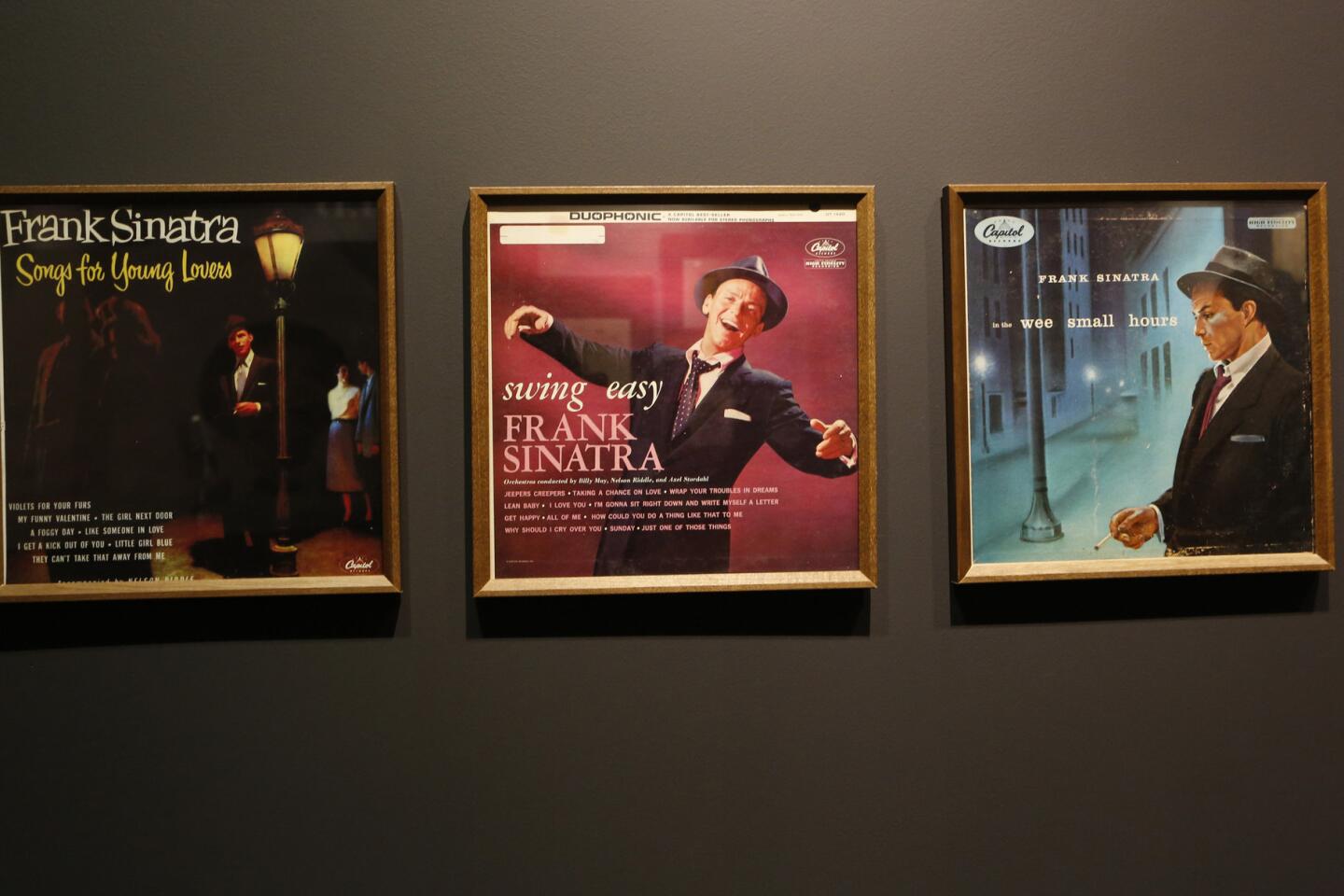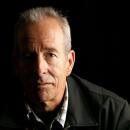‘Sinatra: An American Icon’ is a deep look into Ol’ Blue Eyes at Grammy Museum in L.A.

A short film, “The House I Live In,” in which Frank Sinatra lines up against racial oppression and religious intolerance can be viewed in its entirety at the “Sinatra: An American Icon” centennial exhibition at the Grammy Museum in downtown Los Angeles.
- Share via
The Grammy Museum’s new exhibition marking the 100th anniversary of Frank Sinatra’s birth gives visitors a broad sense of one of the most influential musicians of the 20th century.
“Sinatra: An American Icon,” which has been organized by the Grammy Museum in cooperation with the Sinatra estate, opened earlier this year at the New York Public Library for the Performing Arts. The show drew an estimated 80,000 visitors during its six-month run there.
------------
FOR THE RECORD
An earlier edition of this post listed the date Frank Sinatra died as May 14, 1988. He died May 14, 1998.
------------
“That was great, but also a little intimidating,” said the museum’s manager of traveling exhibitions, Chris Morrison, during a walk-through. The collection occupies most of the facility’s second floor and extends into the ground floor lobby with with a wide range of artifacts on display.
SIGN UP for the free Essential Arts & Culture newsletter >>
Those include Sinatra’s own Dodgers jacket, which he wore to sing the national anthem at opening day of the team’s 1977 season, as well as the fur-lined golf bag containing his set of clubs, a favorite pair of blue cotton pajamas and one of his favorite plaid fedoras.
A timeline across a full wall on the second floor runs the gamut from his birth in Hoboken, N.J., on Dec. 12, 1915, up to his death at 82 from a heart attack on May 14, 1998.
His impact on popular music remains imposing, as will be noted in a tribute concert scheduled for Dec. 2 with plans to be aired as a CBS-TV special on Dec. 6. The show will feature performances and testimonials from a broad swath of admirers including Tony Bennett, Garth Brooks, Alicia Keys, Carrie Underwood, John Legend, Adam Levine, Usher and others.
Unrelated to the Grammy Museum exhibition, Sony Legacy Recordings is also issuing a new four-CD set, “Frank Sinatra: A Voice on Air (1935-1955),” containing more than 100 tracks, the vast majority previously unreleased from his decades as a radio entertainer.
The exhibition is a multimedia exploration of how Sinatra emerged as perhaps the first “teen idol” in American pop culture, drawing young fans who screamed and swooned during his early performances in the late 1930s and early ‘40s.
As Sinatra’s career went on, he created a template for interpreting the Great American Songbook that still echoes on concert stages as well as reality singing contests such as “The Voice” and “American Idol.”
Sinatra got his early break appearing on an early antecedent to those programs, radio’s “Major Bowes Original Amateur Hour.” The scrawny singer with the piercing blue eyes began drawing attention at New York’s Paramount Theatre in performances with clarinetist Benny Goodman’s orchestra. He then became an even bigger star after joining trombonist Tommy Dorsey’s band.
Sinatra was still with the Dorsey orchestra when that group came west in 1942 to inaugurate one of the West Coast’s big new ballrooms, the Hollywood Palladium, a moment that is one of the many underscored in the Grammy Museum show.
As much as Sinatra is widely viewed as an East Coast icon, cemented with his signature version of John Kander and Fred Ebb’s theme for the 1977 film “New York, New York,” Sinatra spent much his life in Southern California once he started making movies in the 1940s.
Frank Sinatra is a singer who comes along once in a lifetime, but why did he have to come in mine?
— Bing Crosby
Among the many photos in the show is a shot of the famous sign over the doorbell of his home in Beverly Hills, which warned potential visitors: “If you haven’t been invited, you better have a damn good reason for ringing this bell!”
“We asked everyone if they knew where that sign went, but we couldn’t locate it,” Morrison said, so a photograph is there instead.
A replica of Capitol Studios’ fabled Studio A in Hollywood, where Sinatra made many of his greatest recordings for Capitol Records, includes a mixing board, a stool and a vintage microphone. The set includes a music stand with sheet music from one of the songs from those sessions -- Alan Bergman, Marilyn Keith and Lew Spence’s “Nice N Easy.”
Interactive elements include a digital jukebox where visitors can listen to recordings as early as his 1939 rendition of “All or Nothing At All” with trumpeter Harry James’ band up to 1984’s “L.A. Is My Lady.” Fans also can sing along with the Chairman of the Board on “That’s Life” in a recording booth or remix his 1984 recording of “Teach Me Tonight” to experience how different emphasis on the various tracks impacts the effect of the song.
Aside from the celebrity memorabilia, the show touches on Sinatra’s history of supporting social justice. Visitors can watch the short film he made in 1945 to accompany the song “The House I Live In,” a plea for understanding among races in the U.S., which received a special Golden Globe award in 1946. The 10-minute film also was singled out for preservation in 2007 by the Library of Congress, which placed it on the National Film Registry. The song, by Earl Robinson and Lewis Allan (a pseudonym used by Abel Meeropol, who also wrote Billie Holiday’s “Strange Fruit”), was inducted into the Grammy Hall of Fame in 1998.
The show traces the influence of black and white entertainers on Sinatra’s approach to singing — in particular Louis Armstrong and Bing Crosby.
“When I started singing in the mid-1930s everybody was trying to copy the Crosby style -- the casual kind of raspy sound in the throat,” Sinatra told an interviewer in 1965. “Bing was on top, and a bunch of us ... were trying to break in. It occurred to me that maybe the world didn’t need another Crosby. I decided to experiment a little and come up with something different.”
It also highlights his friendships with politicians, including President John F. Kennedy and younger brother Robert F. Kennedy, but largely ignores darker aspects of his life such as his reputed ties with organized crime figures.
Several of his nine Grammy awards are on display, and museum officials have incorporated color home movies taken at his residence in Palm Springs. Banners with quotes from and about Sinatra hang over the escalators.
“Frank Sinatra is a singer who comes along once in a lifetime,” Bing Crosby once said of his young acolyte, “but why did he have to come in mine?”
The exhibition is scheduled to run through Feb. 15.
Follow @RandyLewis2 on Twitter. For more on Classic Rock, join us on Facebook.
ALSO:
Garth Brooks, Tony Bennett, more to salute Frank Sinatra’s 100th
Exhibition and book of Mick Rock’s photography looks back on David Bowie
Adele on her new ‘25’ album: ‘Sorry it took so long’
More to Read
The biggest entertainment stories
Get our big stories about Hollywood, film, television, music, arts, culture and more right in your inbox as soon as they publish.
You may occasionally receive promotional content from the Los Angeles Times.

